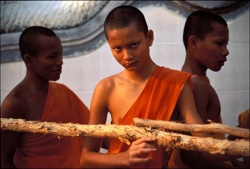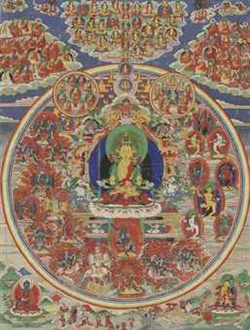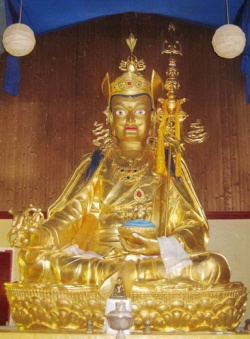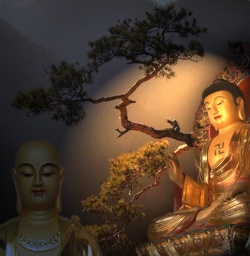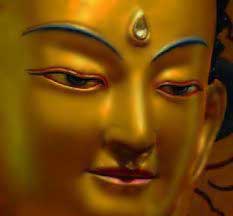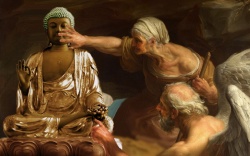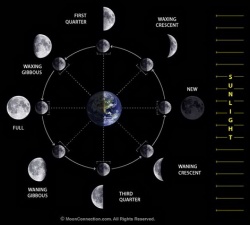Uposatha
The Uposatha (Sanskrit: Upavasatha) is Buddhist day of observance, in existence from the Buddha's time (500 BCE), and still being kept today in Buddhist countries. The Buddha taught that the Uposatha day is for "the cleansing of the defiled mind," resulting in inner calm and joy. On this day, lay disciples and monks intensify their practice, deepen their knowledge and express communal commitment through millennia-old acts of lay-monastic reciprocity. On these days, the lay followers make a conscious effort to keep the Five Precepts or sometimes the 8-precepts. It is a day for practicing the Buddha's teachings and meditation.
Observance days
Depending on the culture and time period, uposatha days have been observed from two to six days each lunar month.
Theravada countries
In general, Uposatha is observed about once a week in Theravada countries in accordance with the four phases of the moon: the new moon, the full moon, and the two quarter moons in between. In some communities, such as in Sri Lanka, only the new moon and full moon are observed as uposatha days.
In Burma, Uposatha (called ဥပုသ် ubot nei) is observed by more pious Buddhists on the following days: waxing moon (လဆန်း la hsan), full moon (လပြည့်နေ့ la pyei nei), waning moon (လဆုတ် la hsote), and new moon (လကွယ်နေ့ la kwe nei). The most common days of observance are the full moon and the new moon. In pre-colonial Burma, the Uposatha day (commonly rendered as the Buddhist Sabbath in English) was a legal holiday that was observed primarily in urban areas, where secular activities like business transactions came to a halt. However, since colonial rule, Sunday has replaced the Uposatha day as the legal day of rest. All major Burmese Buddhist holidays occur on Uposatha days, namely Thingyan, the beginning of the Buddhist lent (beginning in the full moon of Waso, around July to the full moon of Thadingyut, around October). During this period, Uposatha is more commonly observed by Buddhists than during the rest of the year. During Uposatha days, Buddhist monks at each monastery assemble and recite the Patimokkha (a concise compilation of the Vinaya.
For a 2012 calendar of Thai uposatha days, see John Bullitt's "Calendar of Uposatha Days."
Mahayana countries
In Mahayana countries that use the Chinese calendar, the Uposatha days are observed six times a month, on the 8th, 14th, 15th, 23rd and final two days of each lunar month. In Japan, these six days are known as the roku sainichi (六斎日 Six Days of Fasting?).
Names of Full Moon Uposatha Days
The Pali names of the uposatha days are based on the Sanskrit names of the nakśatra (Pali: nakkhatta), the constellations or lunar mansions through which the moon passes within a lunar month.
| Associated Month | Pali | Sanskrit | Burmese | Sinhala | Thai |
|---|---|---|---|---|---|
| January | Phussa | Puṣya | Pyatho | Duruthu | Pusaya (ปุศยะ) |
| February | Māgha | Maghā | Tabodwe | Navam | Makha (มาฆะ) |
| March | Phagguṇa | Phalgunī | Tabaung | Medin (Maedhin) | Pholkuni (ผลคุณี) |
| April | Citta | Chitrā | Tagu | Bak | Chittra (จิตรา) |
| May | Visākhā | Viśākhā | Kason | Vesak | Visakha (วิสาขา) |
| June | Jeṭṭhā | Jyeṣṭha | Nayon | Poson | Chetta (เชษฐา) |
| July | Āsāḷhā | Aṣāḍhā | Waso | Esala (Aesala) | Asarnha (อาสาฬหะ) |
| August | Sāvana | Śrāvaṇa | Wagaung | Nikini | Savana (สาวนะ) |
| September | Poṭṭhapāda | Bhādrapadā | Tawthalin | Binara | Phattarapratha (ภัทรปทา) |
| October | Assayuja | Aśvinī | Thadingyut | Vap | Assavani (อัศวนี) |
| November | Kattikā | Kṛttikā | Tazaungmon | Il | Krittika (กฤติกา) |
| December | Māgasira | Mṛgaśiras | Natdaw | Unduvap | Maruekasira (มฤคศิระ) |
History
The word "uposatha" is derived from the Sanskrit word "upavasatha," which refers to the pre-Buddhistic fast day that preceded Vedic sacrifices.
In the Buddha's time, some ascetics used the new and full moon as opportunities to present their teachings. The Uposatha Day was instituted by the Buddha at the request of King Bimbisara, and the Buddha instructed the monks to give teachings to the laypeople on this day, and told the monks to recite the Patimokkha every second Uposatha day.
Practice
Lay practice
On each uposatha day, devout lay people practice the Eight Precepts.
For lay practitioners who live near a monastery, the uposatha is an opportunity for them to visit a local monastery, make offerings, listen to Dhamma talks by monks and participate in meditation sessions.
For lay practitioners unable to participate in the events of a local monastery, the uposatha is a time to intensify one's own meditation and Dhamma practice, for instance, meditating an extra session or for a longer time, reading or chanting special suttas, recollecting or giving in some special way.
Monastic practice
On the new-moon and full-moon uposatha, in monasteries where there are four or more bhikkhus, the local Sangha will recite the Patimokkha. Before the recitation starts, the monks will confess any violations of the disciplinary rules to another monk or to the Sangha. Depending on the speed of the Patimokkha chanter (one of the monks), the recitation may take from 30 minutes to over an hour. Depending on the monastery, lay people may or may not be allowed to attend.
Communal reciprocity
Describing his experience of Uposatha day in Thailand, Khantipalo (1982a) writes:
"Early in the morning lay people give almsfood to the bhikkhus who may be walking on almsround, invited to a layman's house, or the lay people may take the food to the monastery. Usually lay people do not eat before serving their food to the bhikkhus and they may eat only once that day.... Before the meal the laity request the Eight Precepts [from the bhikkhus] ..., which they promise to undertake for a day and night. It is usual for lay people to go to the local monastery and to spend all day and night there.... [In monasteries where] there is more study, lay people will hear as many as three or four discourses on Dhamma delivered by senior bhikkhus and they will have books to read and perhaps classes on Abhidhamma to attend.... In a meditation monastery ..., most of their time will be spent mindfully employed – walking and seated meditation with some time given to helping the bhikkhus with their daily duties. So the whole of this day and night (and enthusiastic lay people restrict their sleep) is given over to Dhamma...."
Special uposatha days
In Thailand five full-moon uposatha days are of special significance and are called puja, 'days of worship', :
- Visakha Puja or Visakha Uposatha or Vesak("Buddha Day"):
is the most sacred Buddhist holiday. It is the anniversary of the Buddha's birth, awakening and parinibbana.
- Asalha Puja or Asalha Uposatha. ("Dhamma Day"):
anniversary of the Buddha's delivering his first discourse, "Dhammacakka Sutta." The three-month-long Rains Retreat residence starts the following day.
- Pavarana Day:
the end of the Rains Retreat residence during which time each monk atones before the Sangha for any offense they may have committed.
- Anapanasati Day:
Anniversary of the Buddha's delivering the "Anapanasati Sutta." This event is not connected to an Uposatha (Poya) day in Sri Lanka and perhaps is particular to Thailand.
- Magha Puja or Magha Uposatha. ("Sangha Day"):
Anniversary of the assembling of 1250 monks in the Buddha's presence during which time he delivered the "Ovada-Patimokkha Gatha."
In Sri Lanka three full moon Uposatha or Poya days are of special significance.
- Vesak Poya, which is described above.
- Poson Poya corresponds to the Jeṭṭhā uposatha, which falls in June. It is of special significance in Sri Lanka because the arahant Mahinda, King Asoka's son, officially introduced Buddhism to Sri Lanka on this day in the 3rd century B.C.
- Esala Poya corresponds to Asalha (Āsāḷhā) uposatha, the full moon of July, and is described above. This day has special significance in Sri Lanka because it was the day that 56 nobles, headed by Prince Arițțha, became the first Sri Lankans to be fully ordained as a Buddhist monks (bhikkhu) at Cetiyagiri in Mihintale by Mahinda Thera and his companions. It therefore marks the founding of the local Sri Lankan Buddhist monastic Bhikkhu Sangha.
1. Observance of the Eight Precepts;
2. Bi-weekly recitation of the Vinaya rules by a chapter of Buddhist monks
The uposatha are the days of the full moon, half moon and the two quarter moons of each month in the ancient Indian calendar. The day of the full moon (puṇṇamā) was the most important uposatha and marked the beginning of the month. In pre-Buddhist times the upavasatha was the fasting day preceding the Vedic sacrifice. This Sanskrit word and its Pāḷi equivalent mean something like ‘fulfilled.’ In some ways the uposatha is similar to the Jewish and Christian Sabbath, except, of course, that it is not obligatory to observe it. However, the Buddha certainly recommended lay Buddhists use these holidays to ‘purify the soiled mind in the right way’ (upakkilittassa cittassa upakkamena pariyodapana, A.I,207). He encouraged them to pay homage to their parents on such days, to do good works, spend timein quiet contemplation and abide by the eight Precepts (A.I,143; 207). To use the uposatha for such activities was, he said, like polishing a tarnished mirror (A,I,209). He praised reserving the uposatha days for such activities in these words: ‘Pearl, crystal, beryl and gold are not worth a sixteenth of the uposatha made whole with the eight Precepts. Nor is it outshone by the moon and the celestial bodies.’ (A.I,215).
Until the introduction of the Gregorian calendar in most Buddhist countries, the uposathas were public holidays. In Sinhalese they are called poya, in Burmese ubot nei, in Chinese shuo wang, and in Japanese roku sainichi. Monks and nuns use the full and half moon uposathas to chant the Pātimokkha in congregation.

